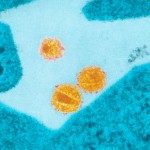Link to Pubmed [PMID] – 9151868
J. Virol. 1997 Jun;71(6):4744-51
The CXCR-4 chemokine receptor and CD4 behave as coreceptors for cell line-adapted human immunodeficiency virus types 1 and 2 (HIV-1 and HIV-2) and for dual-tropic HIV strains, which also use the CCR-5 coreceptor. The cell line-adapted HIV-1 strains LAI and NDK and the dual-tropic HIV-2 strain ROD were able to infect CD4+ cells expressing human CXCR-4, while only LAI was able to infect cells expressing the rat homolog of CXCR-4. This strain selectivity was addressed by using human-rat CXCR-4 chimeras. All chimeras tested mediated LAI infection, but only those containing the third extracellular domain (e3) of human CXCR-4 mediated NDK and ROD infection. The e3 domain might be required for the functional interaction of NDK and ROD, but not LAI, with CXCR-4. Alternatively, LAI might also interact with e3 but in a different way. Monoclonal antibody 12G5, raised against human CXCR-4, did not stain cells expressing rat CXCR-4. Chimeric human-rat CXCR-4 allowed us to map the 12G5 epitope in the e3 domain. The ability of 12G5 to neutralize infection by certain HIV-1 and HIV-2 strains is also consistent with the role of e3 in the coreceptor activity of CXCR-4. The deletion of most of the amino-terminal extracellular domain (e1) abolished the coreceptor activity of human CXCR-4 for ROD and NDK but not for LAI. These results indicate that HIV strains have different requirements for their interaction with CXCR-4. They also suggest differences in the interaction of dual-tropic HIV with CCR-5 and CXCR-4.

